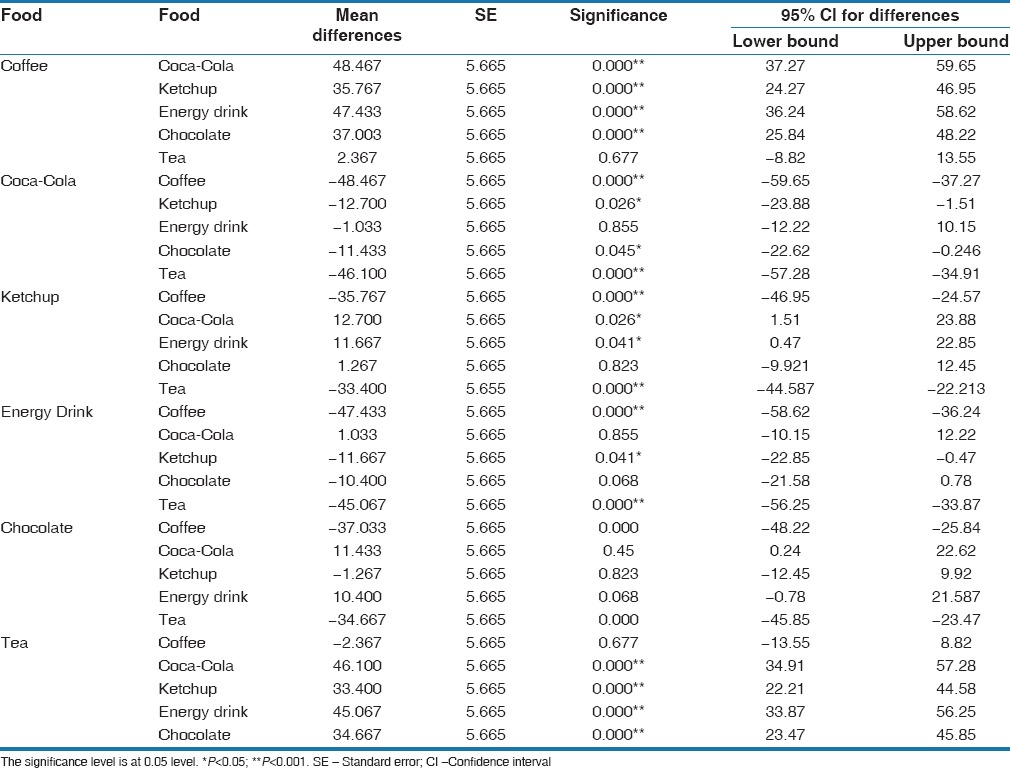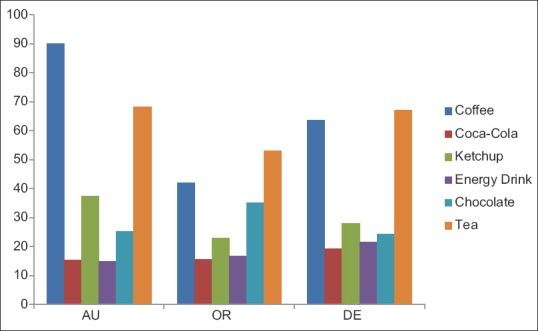Abstract
Objective:
To compare the stain resistance of three types of clear elastomeric modules exposed to several common dietary substances through the assessment of the perception of a group of dentists to discoloration using visual analog scale (VAS).
Materials and Methods:
Elastomeric modules from Unitek (AU), Ormco (OR), and dentaurum (DE) were immersed in the following food substances: Coffee, black tea, chocolate, energy drink, ketchup, and Coca-Cola for 72 h. VAS was used to reflect the module staining severity.
Results:
Significant difference was found among the three types of modules examined in this study. OR modules showed the least mean staining ratings by the examiners. There was no statistical difference in the staining properties between AU and DE modules. Coffee and tea showed higher staining potential as compared to all staining media. Furthermore, there was no difference in the staining characteristics of coffee and black tea.
Conclusions:
Coffee and tea are strong staining media that should be avoided by patients who opted to have esthetic appliances for their orthodontic treatment. Elastomeric modules manufactured by AU showed higher staining optical properties as compared to the other two companies, which could be related to the manufacturing processing of these modules.
Keywords: Color, dental, elastomers, esthetics, orthodontic appliances
INTRODUCTION
The increased esthetic demand of dental and orthodontic patients has guided orthodontists to search for more esthetic solutions to be used in treating their patients.[1,2] These solutions include the use of ceramic and tooth-colored brackets with clear elastomeric modules as a method of wire ligation. One problem arose during the use of these clear elastomeric modules that is discoloration due to the consumption of different food dietary substances.[3,4] The staining properties of these modules led to more frequent replacement by the clinicians and subsequently an increase in the number of follow-up visits and chairside time. Therefore, selecting the most stain resistant modules is essential for clinicians.
The discoloration potential of these elastomeric modules, stem from chemical degradation and mechanical staining. Initially, the discoloration occurs due to chemical degradation then followed by simple mechanical staining over the exposure time to the staining media.[5] The assessment of discoloration of elastomeric modules after exposure to dietary substances can be carried out using digital instrumentation such as cameras or spectrophotometer.[3,5,6,7] These instruments do not provide an insight into the perception of humans to the discoloration and visual esthetic properties of these elastomeric modules.
The staining properties of orthodontic elastomeric modules are directly related to their surface characteristics. Color changes are associated with the type of module that has high surface porosity.[5] Coffee and tea are reported to have rapid staining properties unlike chocolate drink and tomato ketchup, which had gradual staining properties.[2]
The aim of the study was to compare the stain resistance of three types of clear elastomeric modules exposed to several common dietary substances through the assessment of the perception of a group of dentists to discoloration using visual analog scale (VAS).[8]
MATERIALS AND METHODS
Clear elastomeric modules from three major orthodontic companies were examined in the study namely: Unitek (AU) (3M Unitek, Monrovia, California, USA), Ormco (OR) (Ormco Corporation, West Collins Orange, California, USA), and Dentaurum (DE) (Dentaurum Group, Turnstase, Ispringen, Germany). Elastomeric modules from each company were immersed in a capped glass tubes containing 20 ml of the following food substances: Coffee, black tea, chocolate, energy drink, ketchup, Coca-Cola, and distilled water as a control. Coffee and tea were prepared in solutions equivalent to two teaspoons in a standard teacup. The rest of the food and drinks were dispensed directly from their containers.
Glass tubes were stored in a water bath at 37° for 72 h. After that, modules were removed, rinsed with double distilled water, dried and mounted on white cardboards marked with a 100 mm VAS. The identification marks of the manufacturer were covered to ensure equitable judgment. Staining of elastomeric modules was judged blindly by 10 dentists with 1–2 years of experience using the VAS. The left edge of the VAS indicated no staining whereas the right edge indicated severe staining. The evaluators were asked to mark the scale to indicate how severe the staining was. Marks were measured in millimeter to reflect the module staining severity.
The results were analyzed using the SPSS Software 16.0 (SPSS Inc. Released 2007. SPSS for Windows, Version 16.0. Chicago, SPSS Inc). One-way ANOVA, univariate ANOVA, and Tukey's post hoc test were used. The level of significance was set as P < 0.05.
RESULTS
Inter-rater reliability test showed no statistical significant difference among evaluators (P = 0.176) [Table 1]. Univariate ANOVA test showed a significant difference among the three types of modules examined in this study (P < 0.001). OR modules showed the least mean staining ratings by the examiners. Tukey's post hoc pairwise comparisons showed that AU elastomeric modules showed significantly higher staining properties as compared to OR modules (P < 0.05). There was no statistical difference in the staining properties between AU and DE modules. In addition, there was no statistically significant difference in the perception of staining between OR and DE modules [Table 2].
Table 1.
Inter-rater reliability using one-way analysis of variance test to evaluate any statistical differences among evaluators

Table 2.
Post hoc Tukey pairwise comparisons of the mean differences and standard error of ratings among different companies

Coffee and tea showed higher staining potential as compared to all staining media (P < 0.001). Furthermore, there was no difference in the staining characteristics of coffee and black tea. Ketchup has significantly higher staining potential when compared to chocolate and energy drinks (P <<0.05) [Table 3 and Figure 1].
Table 3.
Pairwise comparisons of the mean differences and standard error of ratings among different companies

Figure 1.

A bar graph representing the mean ratings of staining of three types of modules with different dietary substances using visual analog scale. AU – Unitek; OR – Ormco; DE – Dentaurum
DISCUSSION
The current study examined the human perception to the staining properties of commercially available elastomeric modules from three major companies. Evaluating the staining properties of these elastomeric modules that complement the use of esthetic ceramic brackets is important to orthodontists. It gives them an opportunity to select among the auxiliary materials available with confidence, so they can better serve their patient desire for esthetic solutions. In addition, the orthodontist would give certain recommendations and better instruction toward the food and drinks to be avoided during their treatment.
Seventy-two hour of continues immersion and bathing of the material in the food substance is sufficient to simulate the clinical interrupted and infrequent exposure of the modules to staining diet substances during the 3 weeks appointment interval. In addition, the methodology was based on previous published data.[2,6]
The intra-rater reliability using the VAS has been shown to be very high. Using VAS to measure perception has been shown to be sensitive and eliminate evaluators’ bias toward preferred values associated with numerical interval scales.[9,10]
A previous study examined the perception of dental evaluators to determine the staining of clear modules from a single company (AU) exposed to several common food substances over time. It showed that coffee and tea produced severe staining after 6 h of immersion.[4] This result is in agreement with the findings of the current study, which showed that coffee and tea have higher perceived staining as compared to the other tested foods and beverages. However, the current study showed that the Coca-Cola beverage caused staining of the tested modules unlike what was reported previously that Coca-Cola did not produce any staining.[4] The difference between the current study and the previous study is that the previous study examined elastomeric modules from one company and the current study tested elastomeric modules from three different companies. Based on these findings, it is recommended that orthodontists should advice patients, who seek esthetic orthodontic solutions for their appliances, to minimize or avoid coffee and tea drinking during treatment.
The differences in the clinical optical behavior among different commercial companies could be related to the manufacturing process of these modules that will lead to different surface porosities and topographical characteristics of elastomeric modules.[6] The manufacturing process of the tested modules is unknown. Therefore, a comparison of the processing differences among different manufacturers is not possible. Manufacturing process of these elastomeric modules is usually associated with the incorporation of microfissures that can facilitate higher staining potential of certain types of modules.[11] The staining perception of AU modules performed less than the other two companies. This would encourage the manufacturers of these modules to improve or device methods that would insure less surface porosity and subsequently improve the quality of their products.
CONCLUSIONS
Coffee and tea are strong staining media that should be avoided by patients who opted to have esthetic appliances for their orthodontic treatment
Ketchup has significantly higher staining potential when compared to chocolate and energy drinks
Elastomeric modules manufactured by AU showed higher staining optical properties as compared to the other two companies, which could be related to the manufacturing processing of these modules.
Financial Support and Sponsorship
Nil.
Conflicts of Interest
There are no conflicts of interest.
REFERENCES
- 1.Ziuchkovski JP, Fields HW, Johnston WM, Lindsey DT. Assessment of perceived orthodontic appliance attractiveness. Am J Orthod Dentofacial Orthop. 2008;133(4 Suppl):S68–78. doi: 10.1016/j.ajodo.2006.07.025. [DOI] [PubMed] [Google Scholar]
- 2.Faltermeier A, Behr M, Müssig D. In vitro colour stability of aesthetic brackets. Eur J Orthod. 2007;29:354–8. doi: 10.1093/ejo/cjm020. [DOI] [PubMed] [Google Scholar]
- 3.Fernandes AB, Ribeiro AA, Araujo MV, Ruellas AC. Influence of exogenous pigmentation on the optical properties of orthodontic elastic ligatures. J Appl Oral Sci. 2012;20:462–6. doi: 10.1590/S1678-77572012000400012. [DOI] [PMC free article] [PubMed] [Google Scholar]
- 4.Lew KK. Staining of clear elastomeric modules from certain foods. J Clin Orthod. 1990;24:472–4. [PubMed] [Google Scholar]
- 5.Kim SH, Lee YK. Measurement of discolouration of orthodontic elastomeric modules with a digital camera. Eur J Orthod. 2009;31:556–62. doi: 10.1093/ejo/cjp030. [DOI] [PubMed] [Google Scholar]
- 6.Fernandes AB, Ruellas AC, Araújo MV, Sant’Anna EF, Elias CN. Assessment of exogenous pigmentation in colourless elastic ligatures. J Orthod. 2014;41:147–51. doi: 10.1179/1465313313Y.0000000083. [DOI] [PubMed] [Google Scholar]
- 7.Aldrees AM, Al-Foraidi SA, Murayshed MS, Almoammar KA. Color stability and force decay of clear orthodontic elastomeric chains: An in vitro study. Int Orthod. 2015;13:287–301. doi: 10.1016/j.ortho.2015.06.003. [DOI] [PubMed] [Google Scholar]
- 8.Huskisson EC. Visual analogue scales. In: Melzack R, editor. Pain Measurement and Assessment. New York: Raven Press; 1983. pp. 33–7. [Google Scholar]
- 9.Howells DJ, Shaw WC. The validity and reliability of ratings of dental and facial attractiveness for epidemiologic use. Am J Orthod. 1985;88:402–8. doi: 10.1016/0002-9416(85)90067-3. [DOI] [PubMed] [Google Scholar]
- 10.Talic N, Al Shakhs M. Perception of facial profile attractiveness by a Saudi sample. Saudi Dent J. 2008;20:18–23. [Google Scholar]
- 11.Ardeshna AP, Vaidyanathan TK. Colour changes of orthodontic elastomeric module materials exposed to in vitro dietary media. J Orthod. 2009;36:177–85. doi: 10.1179/14653120723166. [DOI] [PubMed] [Google Scholar]


